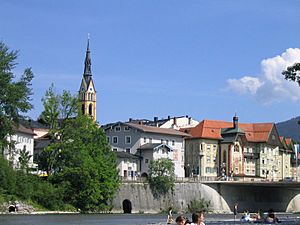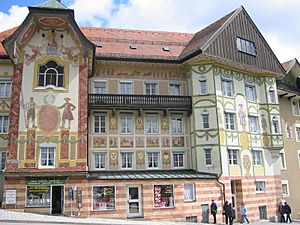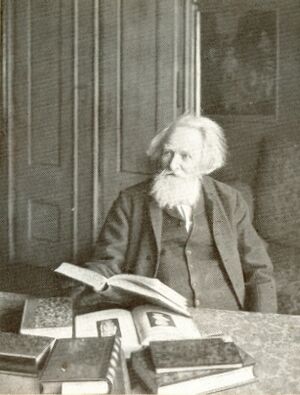Bad Tölz facts for kids
Quick facts for kids
Bad Tölz
|
||
|---|---|---|

Bad Tölz seen from River Isar
|
||
|
||
| Country | Germany | |
| State | Bavaria | |
| Admin. region | Oberbayern | |
| District | Bad Tölz-Wolfratshausen | |
| Elevation | 658 m (2,159 ft) | |
| Population
(2022-12-31)
|
||
| • Total | 19,186 | |
| Time zone | CET/CEST (UTC+1/+2) | |
| Postal codes |
83646
|
|
| Dialling codes | 08041 | |
| Vehicle registration | TÖL | |
| Website | www.bad-toelz.de | |
Bad Tölz is a lovely town in Bavaria, Germany. It's the main town in the Bad Tölz-Wolfratshausen district. This town is famous for its natural healing springs and its beautiful old buildings. It sits right by the Isar River, offering great views of the nearby Alps.
Contents
What is the History of Bad Tölz?
People have lived in the area of Bad Tölz for a very long time. We know this from old tools and items found by archaeologists. These finds date back to the end of the Ice Age. There are even signs of people from the Hallstatt culture and the Roman Empire.
The name "Tölz" first appeared in records around the late 1100s. A local lord, Hainricus de Tolnze, built a castle here. This castle helped control trade along the river and roads. Sadly, the castle is no longer standing today.
How Did Tölz Become a Market Town?
In 1331, Louis IV officially made Tölz a market town. This meant it became an important place for buying and selling goods.
The 14th century was a busy time for Tölz. It became a key spot for trading salt and wood carried on the Isar River.
In 1453, a big fire destroyed many parts of the town. The market street, the church, and the castle were all burned down. But Duke Albrecht III helped the town rebuild. This time, they used stone, which was much stronger. He also built a new palace, but it eventually fell apart by 1770.
What Challenges Did Tölz Face?
The Thirty Years' War (1618–1648) brought a lot of hardship to the region. There was widespread illness and destruction.
Things started to get better during the War of the Spanish Succession. Trade picked up again, especially for lime and wood products. In 1705, a local vintner named Johann Jäger led a group of farmers into battle near Munich.
Tölz also became a popular place for pilgrimages. Every year on November 6, there's a special festival for Saint Leonard of Noblac. A chapel was built in his honor on Calvary hill in 1718.
How Did Tölz Become "Bad Tölz"?
In the mid-1800s, something exciting happened: natural springs were discovered! These springs had special healing properties. The town then started to focus on health and wellness, becoming a famous spa town. Because of its healing springs, the town officially changed its name to "Bad Tölz" in 1899. "Bad" means "bath" or "spa" in German.
Bad Tölz During World War II
During World War II, a training school for officers was set up near Bad Tölz. The town was also affected by the war's end. In 1945, American soldiers arrived in the area, bringing an end to the conflict there. After the war, the former training school became a base for the U.S. Army's 1st Battalion, 10th Special Forces Group until 1991.
What is Bad Tölz Known for Today?
Today, Bad Tölz is still famous for its spas and its beautiful, historic medieval town center. People love the views of the Alps.
On the west side of the Isar River, you'll find the modern spa. Its waters are rich in iodine, which is known for its soothing and healing effects.
A popular attraction was the Alpamare, which was Europe's first indoor water park. It had long water slides, a wave pool, and thermal outdoor pools. It closed in 2015.
Another important landmark is the Stadtpfarrkirche, a church built in 1466. It's a great example of German late–Gothic architecture.
Where is Bad Tölz Located?
Bad Tölz is located right on the Isar River. It sits about 670 meters (2,198 feet) above sea level. The town covers an area of 30.8 square kilometers (11.9 square miles).
What is the Climate Like in Bad Tölz?
Bad Tölz has a humid continental climate. This means it has cool to cold winters and moderately warm summers. The average high temperature for the year is about 10°C (50°F), and the average low is about 4°C (39°F). Being close to the Alps influences its weather.
How Can You Travel to Bad Tölz?
Bad Tölz has good transport links. You can reach it by train using the Bayerische Oberlandbahn railway. This line connects Munich to Lenggries, with a stop in Bad Tölz.
Does Bad Tölz Have Sister Cities?
Yes, Bad Tölz has one sister city. This helps promote friendship and understanding between different places.
Twin Towns and Sister Cities
 Vichy, Allier, Auvergne-Rhône-Alpes, France (since 1965)
Vichy, Allier, Auvergne-Rhône-Alpes, France (since 1965)
Who are Some Famous People from Bad Tölz?
Many interesting people have connections to Bad Tölz. Here are a few:
- Konrad Abeltshauser (born 1992), a professional hockey player.
- Sebastian Horn (born 1982), a musician and TV presenter.
- Eusebius Amort (1692-1775), a Catholic theologian.
- Hans Carossa (1878-1956), a well-known poet and author.
- Annemarie Gerg (born 1975), an alpine skier.
- Michaela Gerg (born 1965), also an alpine skier.
- Rita Kapfhammer (born 1964), a mezzo-soprano singer.
- Johann Nepomuk Sepp (1816-1909), a historian who helped organize the Winzerer monument.
- Thomas Mann (1875-1955), a famous writer who owned a summer house here from 1906 to 1917.
- Grethe Weiser (1903-1970), an actress who sadly passed away in the Bad Tölz hospital after an accident.
- Norbert Schultze (1911-2002), a composer and conductor.
- Marie-Luise Schultze-Jahn (1918-2010), a member of the White Rose, a brave resistance group during WWII.
- Ottfried Fischer (born 1953), a comedian and actor. His role in the TV show Der Bulle von Tölz helped make Bad Tölz even more famous.
See also
 In Spanish: Bad Tölz para niños
In Spanish: Bad Tölz para niños




